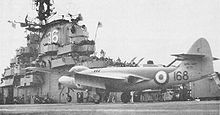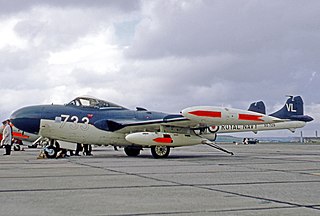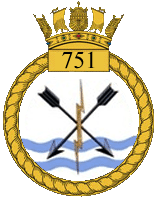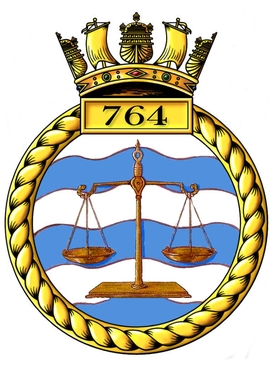The following countries and squadrons operated the Hawker Sea Hawk:
The following countries and squadrons operated the Hawker Sea Hawk:





The Supermarine Attacker is a British single-seat naval jet fighter designed and produced by aircraft manufacturer Supermarine for the Royal Navy's Fleet Air Arm (FAA). It was the first jet fighter to enter operational service with the FAA.

The de Havilland DH.112 Sea Venom is a British postwar carrier-capable jet aircraft developed from the de Havilland Venom. It served with the Royal Navy Fleet Air Arm and with the Royal Australian Navy. The French Navy operated the Aquilon, developed from the Sea Venom FAW.20, built under licence by SNCASE (Sud-Est).

Royal Air Force Kai Tak or more commonly RAF Kai Tak is a former Royal Air Force station situated in Hong Kong, at Kai Tak Airport, Kowloon. It was established by the Royal Air Force (RAF) in 1927 and used for seaplanes. The RAF flight operated a few land based aircraft as well as having spare aircraft for naval units.

Royal Naval Air Station Culham was a former Royal Navy, Fleet Air Arm station near Culham, Oxfordshire. It opened in 1944 as an All-Weather Airfield for the Royal Navy. The airbase was used by Receipt and Despatch Unit No.2, No.1 Ferry Flight, 739 Photographic Trials and Development Unit and home to 1832 R.N.V.R. (Air) Squadron.

Royal Air Force Brawdy, or more simply RAF Brawdy, is a former Royal Air Force satellite station located 6.3 miles (10.1 km) east of St Davids, Pembrokeshire and 9.8 miles (15.8 km) south west of Fishguard, Pembrokeshire, Wales. It was operational between 1944 and 1992; it was used by the Royal Air Force and the Royal Navy (1946–1971), before the site was turned over to the British Army and renamed Cawdor Barracks.

736 Naval Air Squadron was a Fleet Air Arm (FAA) naval air squadron of the United Kingdom’s Royal Navy (RN). It was most recently recommissioned at HMS Seahawk, RNAS Culdrose in June 2013 to fly the BAE Systems Hawk, mainly in the maritime aggressor role, following the disbandment of the Fleet Requirements and Aircraft Direction Unit (FRADU) and operated up until March 2022. It initially formed as the School of Air Combat in May 1943 at HMS Heron, RNAS Yeovilton. In September 1943 it moved to HMS Vulture, RNAS St Merryn, where it became the Fighter Combat School and it created an independent 'B' Flight for fighter affiliation work between March and September 1945. 736 Naval Air Squadron moved to HMS Seahawk, RNAS Culdrose in February 1950 as the Naval Air Fighter School in the 52nd Training Air Group, but disbanded in August 1952. Immediately the following day, the squadron reformed at HMS Seahawk, RNAS Culdrose out of 702 Naval Air Squadron as an Advanced Jet Flying School and in November 1953 it moved to HMS Fulmar, RNAS Lossiemouth. 736 Naval Air Squadron disbanded there in March 1965, but what was left became 764 Naval Air Squadron ‘B’ Flight. The squadron reformed the same day at Lossiemouth from 809 Naval Air Squadron as a Jet Strike Training Squadron. 1966. In March 1967, its aircraft were part of the group that bombed and set on fire the supertanker SS Torrey Canyon aground and leaking crude oil on Seven Sisters rocks off Cornwall. The squadron disbanded in February 1972.

Royal Air Force Hal Far or more commonly RAF Hal Far is a former Royal Air Force station which was the first permanent airfield to be built on Malta. It was operated by the RAF from 1 April 1929 until 1946 when it was transferred and renamed to HMS Falcon, a Royal Navy stone frigate, and was used by Fleet Air Arm crews. It was transferred back to the RAF on 1 September 1965 and returned to the Maltese Government and redeveloped from January 1979. It is now closed and one of its runways is used by drag racing enthusiasts. The second runway is now a road leading to an industrial estate which was developed recently. The Maltese fire service, the CPD occupy the newer building with the glass control tower on the roof. The old Royal Naval Air Station building is now occupied by the International Safety Training College who utilise part of the runway for firefighting training.

703 Naval Air Squadron is a Fleet Air Arm (FAA) naval air squadron of the United Kingdom’s Royal Navy (RN). It was formed as a long-range catapult squadron on 3 March 1942 at RNAS Lee-on-Solent. During the Cold War, it was reformed as an experimental trials unit, and then as a helicopter training squadron. Since 2003, the squadron has formed the Royal Naval wing of the Defence Elementary Flying Training School at RAF Barkston Heath.

895 Naval Air Squadron was a Fleet Air Arm (FAA) naval air squadron of the United Kingdom’s Royal Navy (RN). It was established at HMS Blackcap, RNAS Stretton, as a fighter squadron in November 1942. It started with Hawker Sea Hurricane, which were later changed to Supermarine Seafire. The squadron was disbanded at RAF Turnhouse in June 1943, and provided fighter flights for 816 and 842 Naval Air Squadrons.

897 Naval Air Squadron was a Fleet Air Arm (FAA) naval air squadron of the United Kingdom’s Royal Navy (RN). Established as a fighter squadron at HMS Blackcap, RNAS Stretton, on 1 August 1942, the squadron was disbanded into 801 and 880 Naval Air Squadrons on 3 September. It reformed at HMS Blackcap as a fighter unit on 1 December 1942. On August 4, the squadron joined HMS Unicorn and provided air support for Operation Avalanche, part of the Allied invasion of Italy, in September 1943. The squadron became part of the 3rd Naval Fighter Wing, focusing on tactical reconnaissance and bombardment spotting. It provided cover during the Operation Neptune, the Normandy landings, where it claimed a Messerschmidt Bf 109 and inflicted damage on a midget submarine. The squadron disbanded into 885 Naval Air Squadron on 15 July 1944.

898 Naval Air Squadron was a Fleet Air Arm (FAA) naval air squadron of the United Kingdom’s Royal Navy (RN). The squadron, which was last disbanded at HMS Goldcrest, RNAS Brawdy, on 2 May 1959, was initially established as a fighter unit on 15 October 1942. It joined HMS Victorious in February 1943 and participated in operations over the Coral Sea during May and June, providing support for the landings in the Solomon Islands. After its return to the United Kingdom, the squadron became part of the 7th Naval Fighter Wing. In April 1944, it provided fighter cover for an assault on the German battleship Tirpitz and conducted anti-shipping operations off the coast of Norway from May to June 1944, before disbanding into 882 Naval Air Squadron in July 1944. The squadron was re-established as a fighter unit in January 1945; however, it was too late to engage in further operations, leading to its eventual disbandment in December 1945.

738 Naval Air Squadron was a Fleet Air Arm (FAA) naval air squadron of the United Kingdom’s Royal Navy (RN), which last disbanded during May 1970 at HMS Goldcrest, RNAS Brawdy. It initially formed as a Pilot Training Squadron formed at HMS Asbury, RNAS Quonset Point, Rhode Island, in February 1943. The squadron moved to RNAS Lewiston, Maine, United States, at the end of July 1943 and also providing advanced carrier training to American-trained Royal Naval Volunteer Reserve (RNVR) pilots and it later provided complete Torpedo Bomber Reconnaissance (TBR) aircrew for Grumman Avenger FAA squadrons. The squadron moved to RNAS Brunswick, Maine, in February 1945 and disbanded there in July 1945. 738 Naval Air Squadron was next active as part of the Naval Air Fighter School, between May 1950 and March 1954, providing newly qualified FAA pilots the operational techniques of air-to-air and air-to-ground firing. It had formed at HMS Seahawk, RNAS Culdrose, Cornwall, England, moving to HMS Fulmar, RNAS Lossiemouth in 1953. It reformed in April 1954 at HMS Fulmar and now the squadron’s role was to instruct United States trained pilots on the British method and was also responsible for converting the FAA piston-engined pilots onto jet aircraft. It became an Advanced Flying Training Squadron in June 1962 providing training for low-level navigation, ground attack and air-to-air weapons training.

751 Naval Air Squadron was a Fleet Air Arm (FAA) naval air squadron of the United Kingdom’s Royal Navy (RN). It was initially active as an Observer Training Squadron from 1939 to 1944 as part of No.1 Observer School. 751 Naval Air Squadron formed at RNAS Ford in May 1939. Ford was attacked and bombed, in August 1940, and the following day the squadron relocated to RNAS Arbroath. Twelve months later it moved to RNAS Dundee, remaining there until disbanding at Dundee in May 1944.

764 Naval Air Squadron was a Fleet Air Arm (FAA) naval air squadron of the United Kingdom’s Royal Navy (RN). It initially formed in April 1940, at HMS Daedalus, RNAS Lee-on-Solent, as an Advance Seaplane Training Squadron. The Squadron moved to RAF Pembroke Dock in July 1940, and later to HMS Daedalus II, RNAS Lawrenny Ferry in October 1941 and remaining there until the Squadron disbanded in November 1943. It reformed at HMS Siskin, RNAS Gosport, in February 1944, as the User Trials Unit, however, the squadron was decommissioned for the second time in September 1945. 764 Naval Air Squadron reformed again, at HMS Fulmar, RNAS Lossiemouth, in May 1953, where it became an Advanced Training Unit. It moved to HMS Heron, RNAS Yeovilton, in September 1953, where it received its first jet aircraft. In November 1954 the Squadron disbanded.

781 Naval Air Squadron was a Fleet Air Arm (FAA) naval air squadron of the United Kingdom’s Royal Navy (RN) which disbanded at the end of March 1981. Planned as a Reserve Amphibious Bomber Reconnaissance squadron, it formed as a Communications Unit in March 1940 and operated a large variety of aircraft. It provided a Bristol Beaufighter conversion course which eventually became 798 Naval Air Squadron and also had a ‘B’ Flight at Heathrow and then Heston aerodromes before becoming 701 Naval Air Squadron. After the Allied invasion of Normandy the squadron flew to various Royal Navy units on the continent and established an ‘X’ Flight based in France and then Germany. In July 1945 the squadron disbanded into 782 Naval Air Squadron although the ‘X’ Flight was moved to 799 Naval Air Squadron.

787 Naval Air Squadron was a Fleet Air Arm (FAA) naval air squadron of the United Kingdom’s Royal Navy (RN) which disbanded in January 1956. It formed in March 1941, at HMS Heron, RNAS Yeovilton, out of 804 Naval Air Squadron as a Fleet Fighter Development Unit. Almost every type of fighter was received by the squadron for testing and evaluation for naval use. A move to RAF Duxford in June 1941 saw it become the Naval Air Fighting Development Unit, attached to the Royal Air Force's Air Fighting Development Unit. The squadron undertook rocket projectile test, continuous development of fighter tactics and even helping Torpedo Bomber Reconnaissance squadrons in evading fighter attack. Post Second World War it continued its trials task and also undertook Rebecca radar trials and ASH, US-built air-to-surface-vessel radar trials.

1844 Naval Air Squadron was a Fleet Air Arm (FAA) naval air squadron of the United Kingdom’s Royal Navy (RN) between 1943 and 1945 and then a Royal Naval Volunteer Reserve Air Squadron from 1954 to 1957. It formed in Northern Ireland at HMS Gannet, RNAS Eglinton, in December 1943, as a fighter squadron. It embarked in HMS Begum, in February 1944, for the Far East, arriving in Ceylon, in June and joining HMS Indomitable the following month. August, September and October saw the squadron undertake photographic reconnaissance and provide fighter cover for the attacks on Indaroeng and Emmahaven in Sumatra, then on Sigli, followed by the Nicobar Islands respectively.

871 Naval Air Squadron, also known as VF 871, was a squadron of the Royal Canadian Navy (RCN). It was established in May 1951, and was disbanded in March 1959.